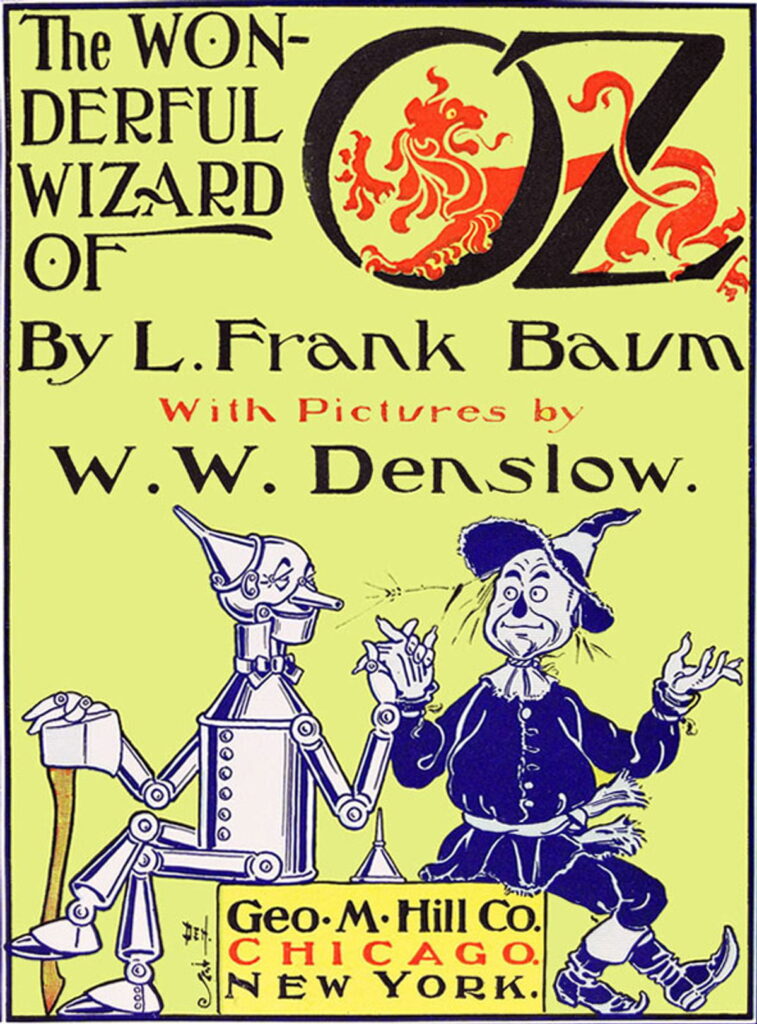In some cases, students caught daydreaming in school are severely punished. In other cases, daydreaming students grow up to create amazing works fueled by their imaginations. And in at least one case, both things were true.
Today is the birthdate of Lyman Frank Baum, who published his many books and stories as “L. Frank Baum.” His most famous work is The Wonderful Wizard of Oz, which you may have heard of. It’s best known today because of the ultra-famous 1939 movie — which, by the way, tells a story that’s quite a bit different from the book.
Baum was born May 15, 1856 in New York state in the US. His family was quite wealthy, and he was mostly tutored at home on their large estate. He was described as a “sickly, dreamy child,” and when he was 12 he was enrolled in a military academy school. He hated it, was badly punished for daydreaming, and finally managed to convince his parents to bring him home after he suffered, of all things, a heart attack. Since he was so young, and never experienced similar symptoms again, his attack is generally supposed to be psychogenic.
Back at home, Baum started writing stories. And (remember, wealthy family) his father bought him a printing press. He and his younger brother published The Rose Lawn Home Journal, which they distributed to family and friends for free. “Rose Lawn” was the name of the family estate. When he was about 17, Baum began publishing another journal, The Stamp Collector, as well as a pamphlet called Baum’s Complete Stamp Dealers’ Directory. He had taken up stamp collecting, and even started a stamp dealership, mostly catering to his friends with the same hobby.
He took up another hobby when he was about 20; breeding chickens. It was a national fad at the time, and his specialty was a breed of chicken called the Hamburg. He was pretty devoted to the hobby, and started a trade journal, The Poultry Record, that was a real, widely distributed publication. He stuck with it for years, and when he was 30 published his first book: The Book of the Hamburgs: A Brief Treatise upon the Mating, Rearing, and Management of the Different Varieties of Hamburgs.
Baum was also obsessed with the theater. He connected with a local theater company, and became a benefactor by paying for all their costumes. He was hoping they’d repay him by casting him in leading roles, but that never happened. So he temporarily abandoned the stage and became a clerk in his brother’s grocery business. He hated that almost as much as he had military school. So he returned to acting, performing as “Louis F. Baum” and “George Brooks.” His father (remember, wealthy family) built him a whole theater, and Baum began writing plays. He hired an acting company to put them on, and the whole operation was fairly successful. Baum, of course, usually played the lead. He even toured with his most successful production, The Maid of Arran.
He got married, and after a fire destroyed his theater (and most of the scripts he’d written), he and his wife moved to the Dakota Territory in the western US. They opened a store, but Baum was a poor businessman and would give products to customers if he thought they needed them. The store went broke, and he became the editor of the local newspaper instead. By this time he was in his early 40s, and hadn’t really found any occupation he really enjoyed. He tried writing for children by publishing Mother Goose in Prose, a retelling of Mother Goose rhymes without the rhyming. It sold pretty well, and he followed it up with Father Goose His Book, which did include the rhyming; it was all nonsense rhymes he wrote. That one was a big success; the best selling children’s book in 1899.
Baum had finally found his calling, and in 1900 published The Wonderful Wizard of Oz. It also became a best seller, and stayed on the best seller list for two years. He continued with a series of 13 more books about the same places and characters. The first book was turned into a stage musical (not by Baum), which was also a big hit.
Baum wrote a number of other books, but while many sold pretty well, he never had another huge success like The Wizard of Oz. He announced plans for an amusement park based on the land of Oz. He detailed his plans to build the park on “Pedloe Island,” off the coast of California, and explained he had discovered the island and would turn it into a “fairy paradise for children.” Nobody has ever located the island, though, and the amusement park was never built. At least not as far as anybody knows. Maybe it’s out there but only accessible if you travel via tornado.
He founded a movie company in 1914, The Oz Film Manufacturing Company, and produced several silent films aimed at children. They didn’t have great success, and the movie company was sold and the name changed. He continued writing, though, and published books both under his own name and using seven different pen names. He wrote at least 45 novels (several were unpublished and have been lost), nearly 100 short stories, hundreds of poems, and over 40 scripts. But he never saw the movie The Wizard of Oz; he died in 1919 at 62. His last Oz book was published posthumously in 1920, and then Oz was continued by other writers, who contributed dozens more titles to the series. You would not believe how many Oz books there are. Baum is credited with the introducing children’s books without the harsh moral lessons that were traditionally included.

